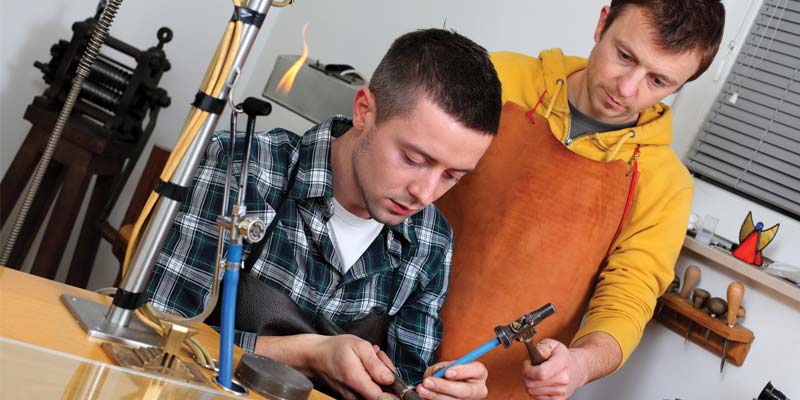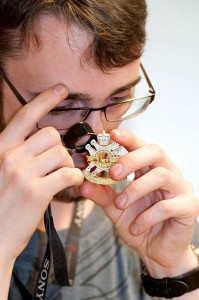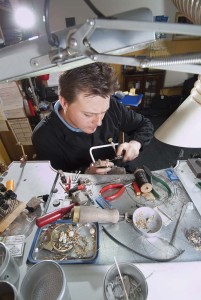Why training young jewellers isn’t just about being in a classroom
by charlene_voisin | August 1, 2014 9:00 am
By Andrea Wenckebach
 [1]
[1]
As educators, we are tasked with providing our students with the knowledge they require to flourish in their craft and find meaningful employment. For its part, the local jewellery industry looks to colleges offering jewellery programs as the means through which to find trained jewellers.
Over the years, however, it’s become apparent these perspectives usually conflict, rather than help serve one another. The disconnect is partly due to the shift in Canada’s manufacturing base to overseas operations where low-cost labour allows for healthier margins. Unfortunately, this has impacted the ongoing training young jewellers receive once they leave school and seek employment. Where in the past they could sharpen their skills at the bench of a local manufacturer, that career path is now very limited and retailers expect students to be fully trained by the time they leave school. And while this may sound perfectly reasonable, the reality is that jewellery arts colleges provide a well-rounded curriculum, but they cannot produce a master bench jeweller over the course of two or three years.
This was the very topic of discussion at a recent gathering of members of the jewellery and metals advisory committee at Georgian College in Barrie, Ont.
At one point, Greg Merrall, co-ordinator of the school’s jewellery and metals program, said, “If I asked students to spend their entire semester soldering broken chains, a task they would routinely encounter as a bench jeweller in a retail environment, how many students do you think I’d have at the end of the semester?” Herein lies the dilemma: how can our program and others like it be all things to all stakeholders?
Picking a path
 [2]
[2]These days, many students do not go on to work in jewellery stores or in manufacturing after graduating. Instead, they start their own companies, making custom pieces for their customers and working the craft show circuit. When their career path is centred on creating one-of-a-kind pieces, students place less emphasis on courses that focus on jewellery repair. At the same time, repair skills are very important for the average family-owned jewellery store, which tends to hire graduates from jewellery programs so they can have a goldsmith onsite. “I want someone who can sit at the bench and do the work,” states Adam LeBoeuf, owner of Bill LeBoeuf Jewellers in Barrie, Ont. While LeBoeuf is a GIA-certified gemmologist, he has limited bench skills and is not in a position to train someone to do repairs. “I’m not a teacher and I don’t have time to do it,” he laments. That leaves employers with employees who have many and varied bench skills, but not necessarily an abundance of advanced jewellery repair experience.
Colin Nash, owner of Nash Jewellers in London, Ont., understands the difficulties of providing students with relevant skills and how they meet the industry’s needs. “The students I hired do high-quality work,” he explains. “However, they both had previous experience in another shop, working under someone before coming here and that made a difference.”
Although he took an intensive three-month course in bench repair, Nash says that when he got back into the shop—and into a real-life environment—he didn’t feel fully prepared for the work asked of him. “Even after graduating, students still need a guide for a couple of years.”
Nash points to apprenticeship programs as a possible solution to the problem of training goldsmiths who specialize in repair work. Unfortunately, Canada has never had any formal jewellery apprenticeship training programs. In other industries, these initiatives are co-dependent, meaning the employer must legally commit to teaching the proscribed theory and practical techniques for an escalating rate of pay over the course of an apprenticeship, which might be five to seven years long. This training is complemented by mandatory trade school classes and curriculum. The apprentice signs on to work and learn for a set number of hours per week with a commitment to periodic reviews of progress by the employer. This type of apprenticeship, which works extremely well in other industries, is either officially recognized by provincial governments and/or industry watchdogs that are mandated to provide oversight.
Unfortunately, rather than formal goldsmithing apprenticeship programs recognized by the provincial governments, Canadian students rely on a dozen or so post-secondary educational institutions offering certificates, diplomas, and degrees of government-accredited courses. Matching want with need, availability, geographic proximity, and access is a challenge for the prospective student and employer. “If there isn’t someone to guide them, I suggest employers hire graduates who’ve had some real-life experience elsewhere,” Nash adds.
Brian Land, an independent retail jewellery consultant, says there is “an expectation [from the industry] that someone coming out of a jewellery program is a master jeweller and would be able to hit the ground running.”
“Yet, the people with these expectations are the same ones who were trained by a father or mother over eight years or more and possibly started out just polishing or only sizing one ring at a time, then having it checked for problems,” says Land, who is former vice-president of sales and operations for Peoples Jewellers. “It takes more than two or three years of school to produce a master jeweller.”
Bridging the gap
 [3]
[3]So how can we bring the two sides closer together? Understanding what is happening in industry and in the schools is a start. Most, if not all, governmental educational institutions have some kind of advisory body offering industry an opportunity for input on a wide range of topics, such as curriculum development, best practices, understanding of trends and standards, support for scholarships, awards, and capital procurement.
While industry provides important and valuable insight into what is needed, it is not possible to achieve all goals in one program.
“Employers tell us we need to teach more repairs,” Merrall says. “However, students often tell us they want to learn to be self-employed. These two things are not mutually exclusive. Employers should consider taking some responsibility for training, as colleges cannot be all things to all people. If repairs are a fundamental part of your business, acknowledge that an entry-level employee will need to have more skills than soldering chains and commit to the training process.”
Land asserts, “We need to understand students are being trained in a number of different areas and that platform allows them to specialize in areas they were taught at school. Mastery at jewellery is not something that happens overnight. It is a lifelong pursuit.”
The needs of industry and educational institutes may not always be aligned. However, if they work with each other and recognize the different opportunities and limitations they each bring to the table, future generations of jewellers on both sides of the equation may be better served.
Andrea Wenckebach is a studio jeweller, as well as the academic program technician and part-time faculty member for the jewellery and metals program at Georgian College in Barrie, Ont. She can be reached at andrea.wenckebach@georgiancollege.ca[4].
- [Image]: http://www.jewellerybusiness.com/wp-content/uploads/2015/11/dreamstime_l_18378510.jpg
- [Image]: http://www.jewellerybusiness.com/wp-content/uploads/2015/11/Kyle-BarrettLoupe-2013.jpg
- [Image]: http://www.jewellerybusiness.com/wp-content/uploads/2015/11/dreamstime_l_24665027.jpg
- andrea.wenckebach@georgiancollege.ca: mailto:andrea.wenckebach@georgiancollege.ca
Source URL: https://www.jewellerybusiness.com/features/why-training-young-jewellers-isnt-just-about-being-in-a-classroom/